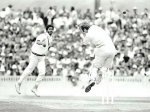...batsmen regularly used to face up to 150kph in the pre-modern pro era without helmets and no one died. we should also have a lot more career ending concussions on record than we do.
getting hit in the head isn't something you just shrug off. 150kph is a loooooot more impact than you need to kill someone. a cricket ball at maximum recorded pace probably has more impact than a king hit and a footpath, and both of those kill daily.
posters will say 'short ball avoidance has declined with helmets so they get hit all the time now, they never used to' and that is ridiculous. if a ball is delivered at the maximum speed a human can manage (20-25 years of regular speed guns - 150-160kph seems to be it) then the human batsman, no matter how good, is going to make a mistake. it's a numbers game. if you are touring the world facing fast bowlers in the nets, facing them in domestic cricket, facing them in test cricket, in those tens of thousands of deliveries you are going to make a mistake and get hit. even bradman got out for low scores, every batsman makes big errors.
cricketers have never been more coached or had more opportunity to learn, and no one wants to get hit in the head regardless of whether they're wearing a helmet. the best aussie since bradman got clocked by jofra archer and i wouldn't be surprised if the helmet saved his life. are you really telling me joe goon with his 27 test batting average in the 1970s facing up to thommo isn't about to meet his maker? please.
i've been hit without a helmet at school facing a kid a few years older and while i showed no sign of anything serious immediately (barely reacted i've been told, so it was play on immediately) i don't remember the game after that moment at all. that's sobering, and it was a hit at school kid pace which is what, 100kph slower than mitchell starc?
did cricket just get lucky? i know ewen chatfield almost died on the field, and i've heard other examples, but overall we've been extremely fortunate given the amount of short balls bowled at pace in the past hundred years or so.



